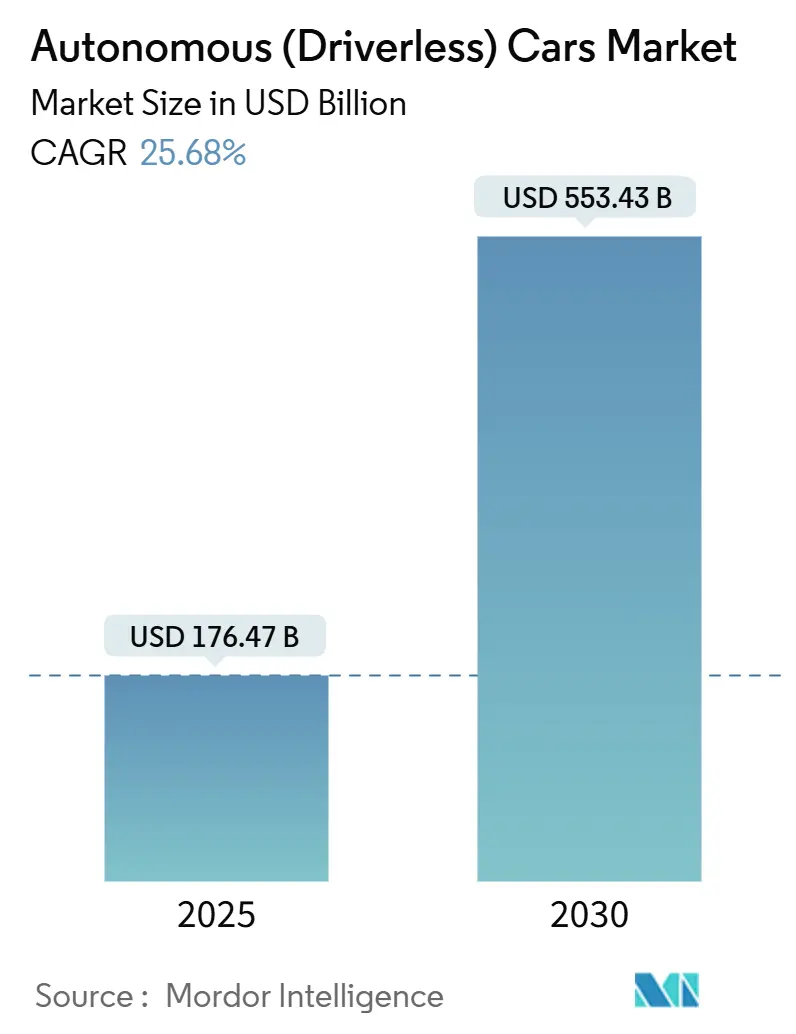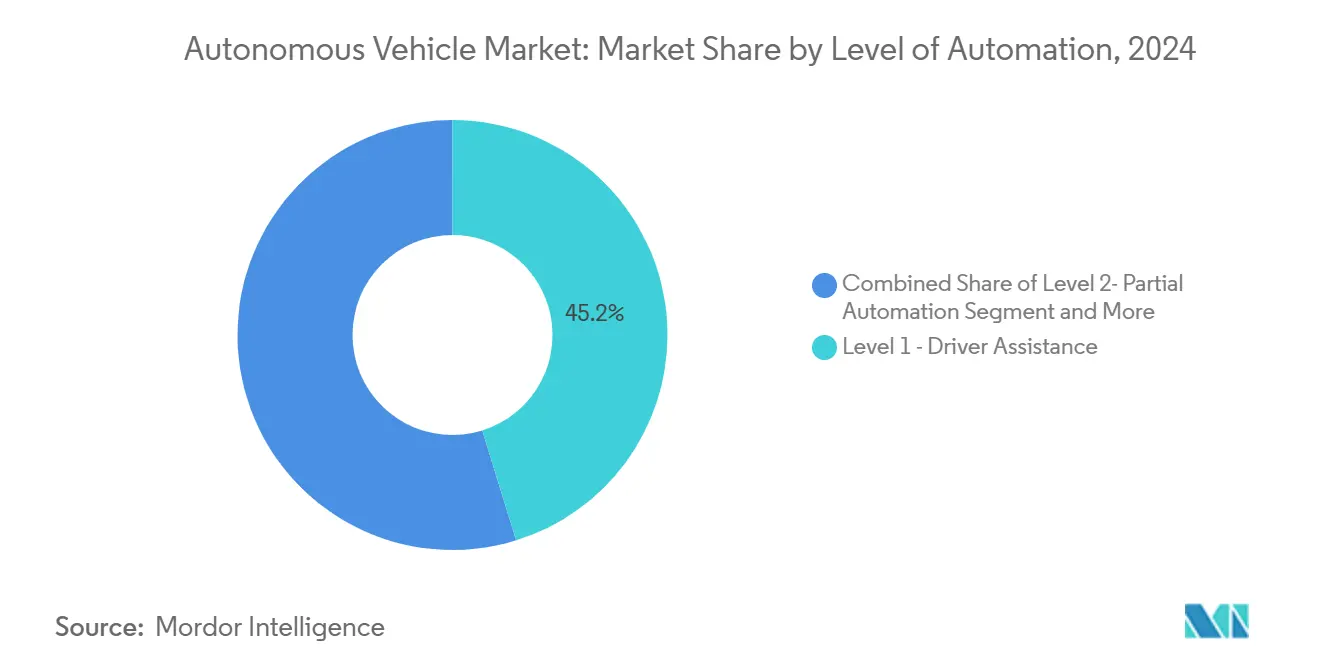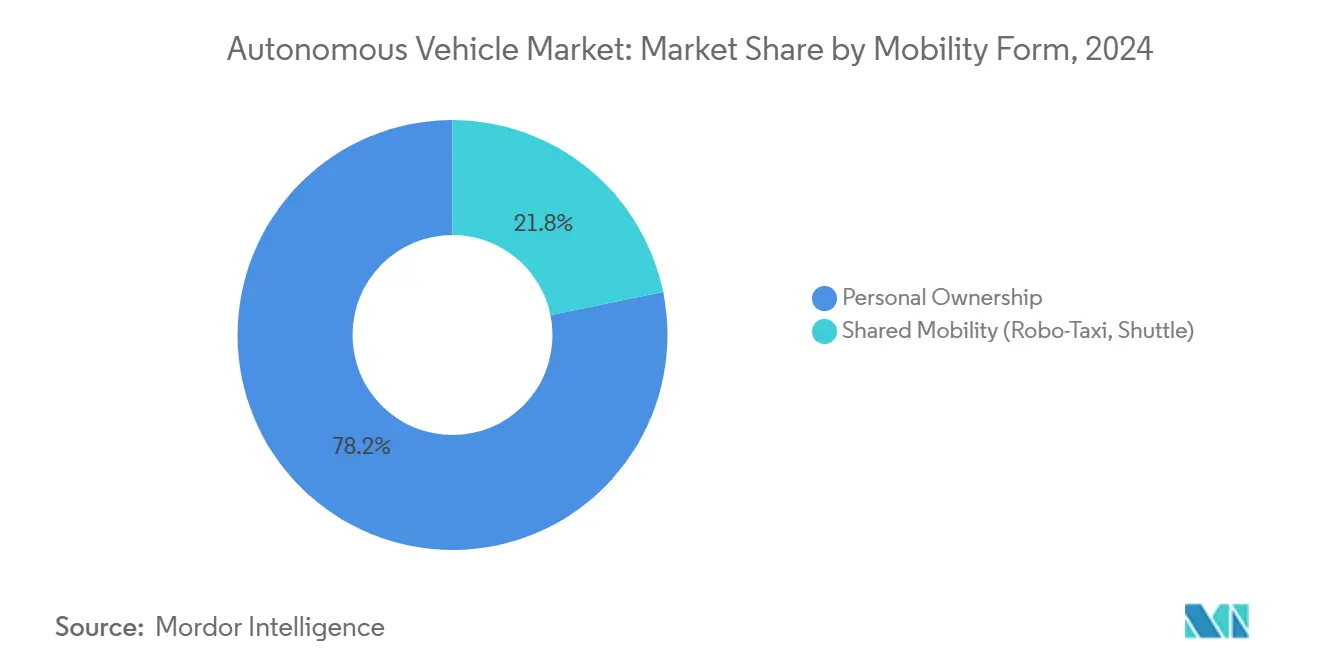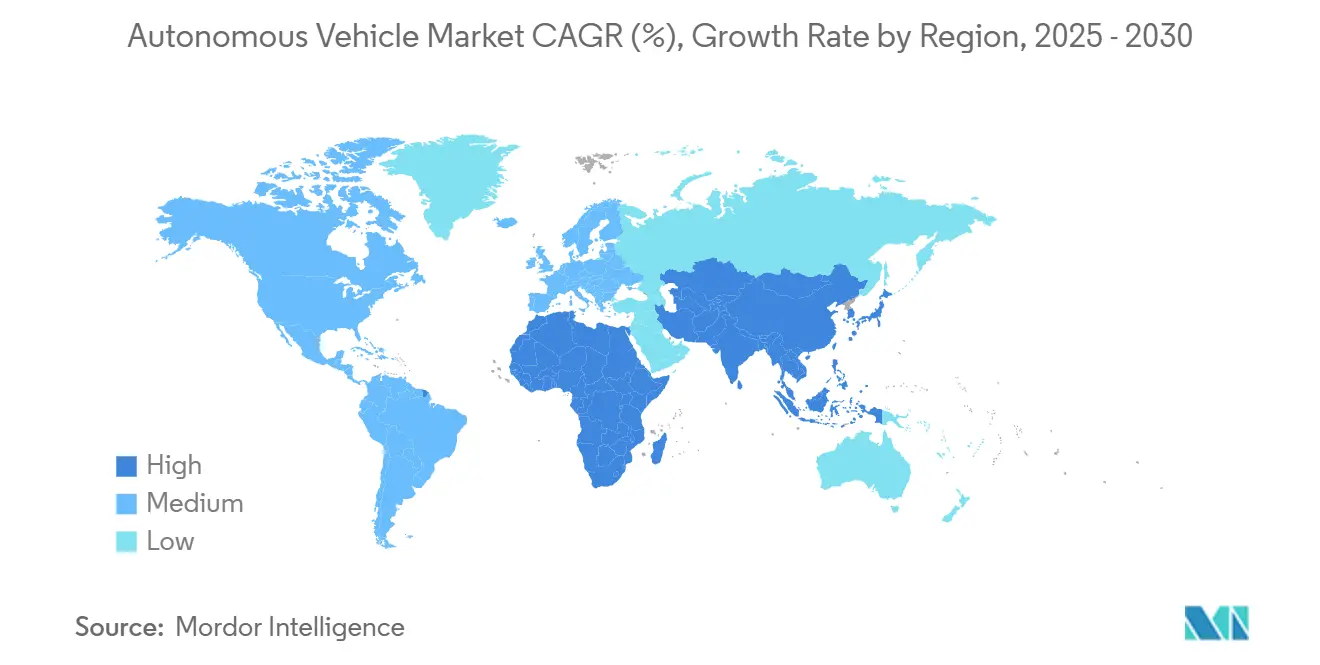Autonomous (Driverless) Cars Market Size and Share

Autonomous (Driverless) Cars Market Analysis by Mordor Intelligence
The autonomous (driverless) cars market size stands at USD 176.47 billion in 2025 and is projected to reach USD 553.43 billion by 2030, registering a 25.68% CAGR during 2025-2030. Regulatory mandates that force advanced driver-assistance hardware into every new light vehicle, combined with steady double-digit sensor price erosion, keep capital flowing into higher-automation programs. Asia-Pacific’s early lead, built on municipal robotaxi licenses and aging-population mobility reforms, shapes supply-chain priorities across global automakers. Battery-electric platforms gain design precedence because unified high-voltage wiring looms simplify integration of compute, actuators, and redundant power rails. At the same time, fleet operators validate the per-mile economics of driverless shuttles in geofenced corridors, giving investors a clear payback path. Nonetheless, localized chip shortages, a patchwork of U.S. state regulations, and recurring high-definition map-update costs in emerging regions still dilute return profiles in the near term.
Key Report Takeaways
- By level of automation, Level 1 driver assistance led with 46.17% of autonomous car market share in 2024, while Level 5 full automation is forecast to expand at a 26.93% CAGR to 2030.
- By vehicle type, SUVs and MPVs captured 80.65% revenue share in 2024; hatchbacks and sedans together are advancing at a 25.44% CAGR through 2030.
- By propulsion type, internal-combustion platforms held 63.68% of the autonomous car market size in 2024, yet battery electric vehicles are projected to grow at a 34.82% CAGR between 2025-2030.
- By mobility form, personal ownership accounted for 79.88% of 2024 revenue, whereas shared mobility is forecast to post a 29.99% CAGR through 2030.
- By component, hardware commanded 58.58% of 2024 revenue, while software is rising at a 26.52% CAGR over the forecast period.
Global Autonomous (Driverless) Cars Market Trends and Insights
Drivers Impact Analysis
| Driver | (~)% Impact on CAGR Forecast | Geographic Relevance | Impact Timeline |
|---|---|---|---|
| ADAS-Centric Safety Regulations | +6.5% | Europe, China, APAC core with spill-over to MEA | Medium term (2-4 years) |
| Falling LiDAR and AI Compute Costs | +5.8% | Global | Short term (≤ 2 years) |
| Rapid Expansion of Robo-Taxi Pilots | +4.2% | APAC (China, Japan, South Korea), spill-over to Middle East | Medium term (2-4 years) |
| Power-Efficient Automotive SoCs | +3.5% | Global | Short term (≤ 2 years) |
| Fleet Decarbonization Targets | +2.8% | Europe, North America | Long term (≥ 4 years) |
| 5G-V2X Corridor Roll-outs in North American Freight Networks | +2.4% | North America, early adoption in Europe | Long term (≥ 4 years) |
| Source: Mordor Intelligence | |||
Government Mandates for ADAS-Centric Safety Regulations in EU and China
The European Union’s General Safety Regulation and UNECE UN R157 standardize automated lane-keeping requirements, prompting OEMs to install multi-sensor arrays and redundant compute across new models. China broadened fully driverless permits to four tier-one cities in 2024, allowing Baidu’s Apollo Go to price fares at 4 yuan and seize up to 70% ride-hailing share in pilot districts. Japanese mobility strategies now tie semiconductor policy directly to autonomous-driving demonstrations, ensuring cohesive supply-chain funding. Together, these mandates compress validation timelines and create a global compliance baseline that late-moving regions must match or risk capital flight.
Falling LiDAR and AI Compute Costs Unlocking Mass-Market L3 Launches
Hesai’s plan to push LiDAR bill-of-materials below USD 500 makes redundant perception affordable for volume sedans, while NVIDIA and Qualcomm slashed compute cost per TOPS to under USD 0.50 in 2024. BMW’s EUR 6,000 Highway Assistant bundle shows consumers will pay for extended hands-off capability once price points align with mainstream trims. As dual-redundant SoCs migrate onto single high-performance die, ISO 26262 documentation shortens, pushing Level 3 from luxury exclusivity to mass-segment reality. Sensor-compute cost parity allows the addressable market to jump from 2 million units in 2024 to a projected 15 million units by 2030.
Rapid Expansion of Robo-Taxi Pilots across Asian Mega-Cities
Chinese city governments grant continuous service licenses that let operators scale fleets rapidly, contrasting sharply with U.S. city-by-city waivers. Pony.ai intends to lift its fleet from 200 units in 2024 to over 1,000 in 2025, hitting economic break-even on utilization alone. WeRide’s 50-vehicle shuttle service in Guangzhou integrates existing transit fare cards, illustrating that L4 shuttles can fit into public networks without new lanes. The dense Asian mega-city model amplifies ride density, thus driving down cost per kilometer and accelerating consumer acceptance.
Power-Efficient Automotive SoCs Enabling In-Vehicle Edge AI
NVIDIA’s DRIVE Thor achieves 2,000 TOPS at sub-200-watt thermal envelopes, keeping cabin cooling loads inside existing HVAC limits. Mobileye’s EyeQ6 supplies vision-centric perception to multiple Volkswagen premium brands beginning 2024, solidifying SoC vendor lock-in. Single-chip consolidation trims wiring harness mass, shortens safety-case documentation, and frees under-hood real estate for additional battery modules on BEV platforms.
Restraints Impact Analysis
| Restraint | (~)% Impact on CAGR Forecast | Geographic Relevance | Impact Timeline |
|---|---|---|---|
| State-Level AV Regulations in the United States | -3.2% | United States, spill-over to Canada | Medium term (2-4 years) |
| Public Mistrust Intensified | -2.8% | China, APAC, global perception impact | Short term (≤ 2 years) |
| Automotive-Grade AI Chip Shortages | -2.1% | Global | Short term (≤ 2 years) |
| High-Definition Map Maintenance Costs in Emerging Markets | -1.5% | Emerging markets (South America, Africa, Southeast Asia) | Long term (≥ 4 years) |
| Source: Mordor Intelligence | |||
Patchwork State-Level AV Regulations in the United States Delay Commercial Scale
California, Arizona, and Texas each set different incident-reporting thresholds and cybersecurity attestations; fleets must re-engineer compliance paperwork for every border cross, adding up to 24 months to expansion roadmaps. The absence of federal preemption diverts venture funding toward legal teams instead of vehicle buys, slowing roll-outs relative to centralized approval regimes in China and the EU.
Public Mistrust Intensified by High-Profile Robotaxi Incidents in China
A Baidu robotaxi collision in Wuhan during August 2024 received outsized social-media attention, temporarily suspending service and reinforcing consumer skepticism. Surveys show more than 40% of respondents in Japan and China refuse to board a driverless vehicle without a safety operator, forcing operators to maintain costly remote-assist staffing that undercuts profit margins.
Segment Analysis
By Level of Automation: Liability Shifts Propel Higher Levels
Level 1 features such as lane-keep and adaptive cruise controlled 46.17% of the autonomous car market in 2024 as they came bundled on most new vehicles to meet UNECE rules. Level 5 fleets remain small but will post the segment’s strongest 26.93% CAGR to 2030 as cities grant driver-out permits and sensor costs fall. Level 3 approvals, led by Mercedes-Benz in Germany, transfer legal responsibility to the manufacturer within specific domains, accelerating consumer uptake. Level 4 shuttles concentrate on fixed-route commercial applications, where constrained environments simplify validation and encourage early revenue generation.
The coexistence of personal-ownership L1-L3 and fleet-based L4-L5 creates distinct revenue models. Subscribers pay monthly fees to unlock new vision features on privately owned cars, while mobility providers chase cost-per-mile targets through high utilization. Japan’s national Mobility DX Strategy aims for 30% global software-defined-vehicle share by 2030 and channels public funding toward L4 trials in aging rural prefectures. Liability clarity, fleet economics, and consumer trust decide which automation tiers hit scale first.

Note: Segment shares of all individual segments available upon report purchase
By Vehicle Type: Elevated Rooflines Ease Sensor Placement
SUVs and MPVs amassed 80.65% of autonomous car market revenue in 2024 thanks to high rooflines that give LiDAR and camera arrays unobstructed 360-degree views. They retain a 25.44% CAGR through 2030 because global consumers favor tall-ride vehicles. Lower hatchbacks and sedans face tighter packaging for roof-mounted pods and therefore incur higher wind-noise penalties when retrofitted. However, their superior aerodynamics let fleet operators squeeze extra range from battery packs on urban routes.
Sedans remain relevant for price-sensitive Level 1 and Level 2 deployments. Compact shuttles, such as Toyota’s driverless Odaiba service, prove that narrow bodies suit dense city cores where lane widths are restricted. Platform choice balances sensor integration, consumer taste, and use-case range economics.
By Propulsion Type: Unified Electrical Platforms Accelerate Autonomy
Internal-combustion models held 63.68% share in 2024, yet BEV platforms expand at a blazing 34.82% CAGR to 2030. A skateboard chassis and centralized power distribution make it easier to accommodate dual redundant compute without extensive harness rework. Over-the-air updates patch autonomy algorithms weekly, keeping fleets within regulatory compliance without service-bay visits.
Hybrid architectures act as transitional choices in charging-infrastructure-constrained regions but add mechanical complexity that multiplies failure modes. OEM roadmaps now treat BEV as the default for new Level 4 projects, leaving ICE vehicles to support legacy ADAS until fleet turnover completes.
By Mobility Form: Utilization Economics Favor Shared Fleets
Personal ownership dominated 79.88% of 2024 sales. Still, shared mobility will grow at a 29.99% CAGR because ride density lets fleets amortize sensors across high daily mileage. Pony.ai expects positive operating income once its robotaxi fleet tops 1,000 units, a target for 2025. Waymo’s 150,000 weekly rides already out-earn traditional taxis by 15-20% per mile.
Suburbs and rural zones keep private-vehicle sales resilient where parking is plentiful and trip density low. Urban centers tilt toward autonomous shuttles and robo-taxis as congestion pricing and parking scarcity bite. OEMs hedge risk with dual-purpose platforms designed for both purchase and fleet lease.

By Component: Software Recurring Revenue Surges
Hardware captured 58.58% of 2024 revenue, but the software line item is rising at 26.52% CAGR as manufacturers unbundle features into monthly subscriptions. Perception, planning, HD maps, and driver monitoring upgrade over time, creating annuity streams that outlast the initial sale. Mobileye’s combined hardware-software deal with Volkswagen splits lifetime value roughly 60-40, revealing shifting value capture depths.
Services—remote operations centers and validation tooling—account for the smallest slice but remain essential for handling edge-case interventions beyond the operational design domain. As LiDAR commoditizes, margin migrates from sensor sales to algorithm IP and data-service tiers.
Geography Analysis
Asia-Pacific controlled 47.51% of 2024 autonomous car market volume, growing at a forecast 22.58% CAGR. China sanctioned driver-out robotaxis in its four largest cities in 2024, enabling Baidu to drop fares to taxi-beating levels and capture up to 70% share in launch districts. Japan’s senior-driver restrictions create captive demand for Level 2+ vehicles, while South Korea invests in nationwide 5G-V2X corridors to future-proof freight lanes. Cross-border technology alliances between Japanese OEMs and Chinese cloud giants underscore the region’s integrated ecosystem.
North America follows with a 17.45% CAGR through 2030. The U.S. National V2X Plan, finalized in 2024, earmarks nationwide cellular coverage for low-latency vehicle messaging, yet commercial scale is hampered by non-uniform state regulations. Freight-oriented autonomy grows fastest; Texas-based terminals serve middle-mile electric trucks that avoid complex downtown mixes.
Europe records a 15.40% CAGR as UNECE type-approval harmonization and strict CO₂ targets steer funding toward electric autonomous freight corridors. Carrefour’s and DHL’s pilot programs validate cost-per-mile advantages, and regional governments subsidize charging hubs along key logistics routes to attract fleet operators.
Middle East and Africa log the highest regional CAGR at 27.83%. Smart-city blueprints in the UAE and Saudi Arabia embed autonomous shuttles inside transport architecture from the outset. Dubai’s TXAI buses run mixed-traffic routes and share payment systems with metros, signaling a deliberate leapfrog over incremental ADAS phases. Latin America and Africa progress more slowly because of mapping costs and intermittent 5G coverage, but campus-scale deployments in Brazil and South Africa provide controlled-environment proofs of concept.

Competitive Landscape
The top five automakers—Toyota, Volkswagen, BMW, Mercedes-Benz, and Tesla—controlled 83.96% of autonomous car market share in 2024, yet fragmentation rises as Baidu, Pony.ai, and AutoX build fleets outside conventional dealer networks. Incumbent OEMs bundle Level 2 subscriptions, such as Mercedes Drive Pilot at EUR 6,000, to convert hardware capex into recurring revenue. Technology suppliers NVIDIA, Qualcomm, and Mobileye embed full software stacks on their SoCs, enabling OEMs to fast-track safety validation by buying turnkey solutions.
Chinese urban robotaxi operators wage price wars, with Baidu offering 4-yuan fares that undercut taxis by more than half. U.S. disruptors Nuro and Waabi narrow operating domains to last-mile delivery and interstate freight, respectively, where simplified scenarios reduce validation cost. Technology differentiation now hinges on sensor fusion philosophy: Tesla pursues vision-only perception, whereas Volkswagen-Mobileye rely on 13-camera, 9-LiDAR, 5-radar redundancy, proving that multiple safety-case narratives can coexist.
Tier-1 suppliers face margin compression as hardware commoditizes and OEMs insource software. Hesai’s USD 300 million LiDAR deal with Baidu typifies exclusive supply contracts that lock in volume but at lower unit prices. Competitive advantage is migrating from plant throughput to control of data, over-the-air deployment pipelines, and municipal regulatory alliances.
Autonomous (Driverless) Cars Industry Leaders
-
Tesla, Inc.
-
Volkswagen AG
-
Toyota Motor Corporation
-
Mercedes-Benz Group
-
BMW
- *Disclaimer: Major Players sorted in no particular order

Recent Industry Developments
- May 2025: Waymo secured approval from the California Public Utilities Commission to expand its autonomous ride-hailing service across the wider San Francisco Bay Area. The decision follows the company’s March safety plan filing and signals regulatory confidence in existing operational safeguards.
- May 2025: Uber and WeRide announced plans to extend joint autonomous operations to 15 cities within two years. The expansion underlines rising strategic alignment between ride-hailing and dedicated AV software providers.
- January 2025: Amazon-owned Zoox started an Early Rider Program in Las Vegas to pave the way for commercial robotaxi service later in the year. The initiative will deploy vehicles without manual controls in multiple U.S. cities.
Research Methodology Framework and Report Scope
Market Definitions and Key Coverage
Our study treats the global autonomous-car market as revenue generated from the factory sale of passenger and light commercial vehicles equipped with Society of Automotive Engineers (SAE) Level 3 through Level 5 automation hardware, software, and integrated services. Vehicles restricted to Level 0-2 driver assistance are tracked only as feeder data for penetration analysis.
Scope exclusion: aftermarket retrofit kits and off-road specialty vehicles are not counted.
Segmentation Overview
- By Level of Automation
- Level 1- Driver Assistance
- Level 2 - Partial Automation
- Level 3 - Conditional Automation
- Level 4 - High Automation
- Level 5 - Full Automation
- By Vehicle Type
- Hatchbacks
- Sedans
- SUVs and MPVs
- By Propulsion Type
- Internal Combustion Engine (ICE)
- Battery Electric Vehicles (BEV)
- Hybrid Electric Vehicles (HEV)
- By Mobility Form
- Personal Ownership
- Shared Mobility (Robo-Taxi, Shuttle)
- By Component
- Hardware
- Sensors (LiDAR, RADAR, Cameras, Ultrasonic, IMU)
- Computing Platforms (SoCs, GPUs)
- Actuators and Control Systems
- Software
- Perception and Planning Suites
- Mapping and Localization Engines
- Driver Monitoring and HMI
- Services
- Integration and Validation
- Remote Operation and Tele-operation
- Hardware
- Geography
- North America
- United States
- Canada
- Rest of North America
- South America
- Brazil
- Argentina
- Rest of South America
- Europe
- Germany
- France
- United Kingdom
- Italy
- Spain
- Rest of Europe
- Asia-Pacific
- China
- Japan
- South Korea
- India
- Rest of Asia-Pacific
- Middle East and Africa
- South Africa
- Egypt
- United Arab Emirates
- Saudi Arabia
- Turkey
- Rest of Middle East and Africa
- North America
Detailed Research Methodology and Data Validation
Primary Research
Multiple touch points with OEM autonomy program leads, LiDAR chipset chiefs, fleet operators in China, Europe, and the United States, plus regulators vetting UN R157 pilots, allow us to verify deployment timetables, average selling prices, and risk adjustment factors; these conversations close data gaps uncovered during desk work and refine regional adoption curves.
Desk Research
Mordor analysts start with curated public datasets such as OICA production volumes, NHTSA Automated Vehicle STEP filings, UNECE WP.29 type approval registers, and China MIIT homologation lists, which signal legitimate L3-L5 launches. We enrich these with trade association dashboards (SAE, ACEA, ITS America), import-export logs from Volza, and patent clusters extracted via Questel that spotlight sensor fusion breakthroughs. Company 10-Ks and investor decks then anchor pricing corridors for LiDAR, domain controllers, and AI software stacks. Select paid libraries, D&B Hoovers for OEM financials and Dow Jones Factiva for deal flow, round out the desk work. This inventory is illustrative rather than exhaustive.
Market-Sizing & Forecasting
We apply a top-down build: global light vehicle output is multiplied by region-specific autonomy-ready penetration rates, themselves modeled from regulatory milestones, sensor cost trajectories, and battery electric uptake. Select bottom-up cross checks, sampled ASP x unit roll-ups from five leading OEM programs and robotaxi service miles, help tune totals. Key variables include solid-state LiDAR price decline, GSR2 and NHTSA rule timing, robotaxi pilot kilometers, semiconductor compute density, and BEV share of new sales. Forecasts rely on multivariate regression blended with scenario analysis to capture policy or cost shocks; gaps in supplier data are bridged through weighted averages derived from nearest comparable models.
Data Validation & Update Cycle
Outputs pass a three-layer review: automated variance scans against historic ratios, peer analyst audit, and final senior sign-off. We revisit models annually and trigger interim updates when material events occur, such as regulatory approvals, flagship L4 launches, or >=10% cost swings, ensuring clients receive a fresh baseline at delivery.
Why Mordor's Autonomous Car Baseline Commands Confidence
Published numbers diverge because firms differ on which automation tiers, vehicle classes, and ASP assumptions they include and how frequently they refresh them.
By hewing to an L3-L5 definition, using live cost curves, and updating every twelve months, Mordor delivers a balanced, decision-ready baseline.
Benchmark comparison
| Market Size | Anonymized source | Primary gap driver |
|---|---|---|
| USD 32.89 B (2024) | Mordor Intelligence | - |
| USD 68.09 B (2024) | Global Consultancy A | Includes Level 1-2 units and counts defense contracts, inflating value |
| USD 207.38 B (2024) | Industry Analyst B | Applies list prices, bundles connected car and HD map services |
In sum, while other publishers swing wide due to broader scopes, price multipliers, or slower refresh cadences, our disciplined variable selection and continuous validation give stakeholders a transparent yet conservative reference point they can confidently build plans upon.
Key Questions Answered in the Report
How fast is the autonomous car market growing between 2025 and 2030?
The autonomous car market size is forecast to rise from USD 139.67 billion in 2025 to USD 553.43 billion by 2030, reflecting a 25.68% CAGR.
Which vehicle type captures the largest share of autonomous deployments today?
SUVs and MPVs hold 80.65% revenue share because higher rooflines simplify 360-degree sensor placement.
Why are battery electric vehicles central to future autonomous programs?
BEV platforms offer unified electrical architectures that ease integration of redundant compute and enable seamless over-the-air updates.
What limits large-scale robotaxi roll-outs in the United States?
Divergent state-level regulations require separate permits and liability frameworks, adding up to two years to expansion schedules.
Which region will post the fastest growth through 2030?
The Middle East and Africa, propelled by smart-city investments in the UAE and Saudi Arabia, show a projected CAGR of 27.83%.
Page last updated on:



